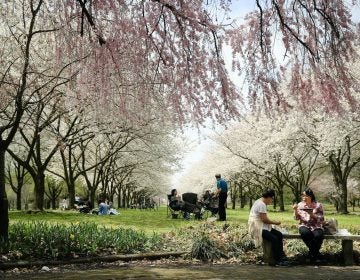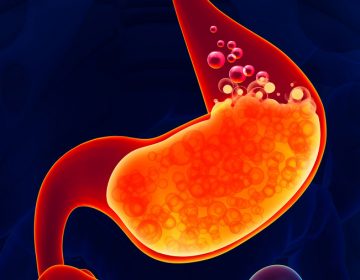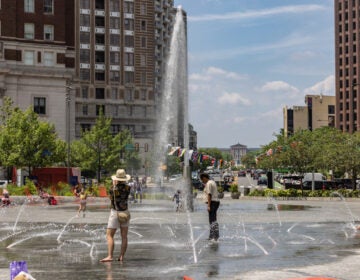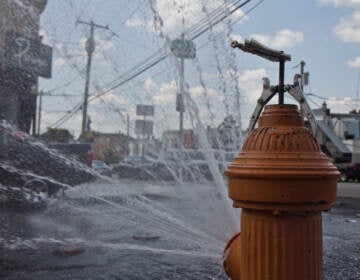Philly, meet the new normal of spring allergy season
Tree and grass pollen are at extreme levels, according to local pollen counts. Experts say climate change is to blame for longer allergy seasons.
Listen 1:05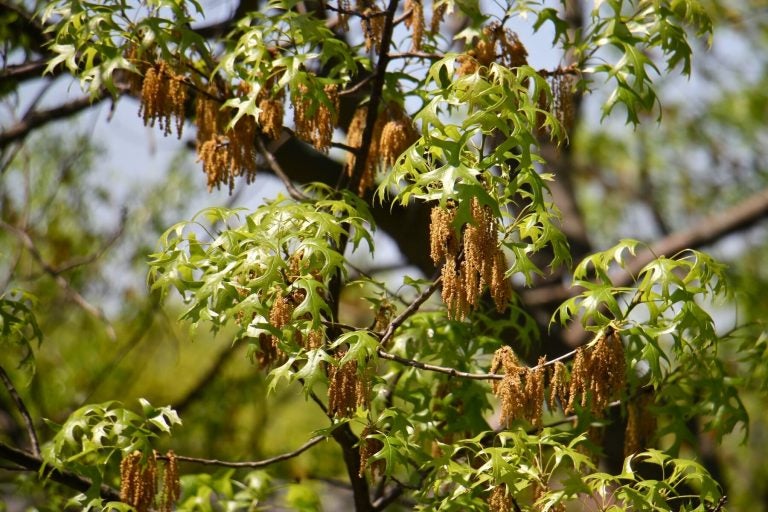
Oak tree pollen (Emma Lee/WHYY News)
From Philly and the Pa. suburbs to South Jersey and Delaware, what would you like WHYY News to cover? Let us know!
On the rooftop of the Asthma Center in Center City, Philadelphia, there is a box-shaped sensor device not much larger than a briefcase.
The machine takes hourly air sample images that can capture microscopic pollen particles. The images are then analyzed with the help of artificial intelligence to measure the concentration of pollen in the air at any given time.
This real-time data show that tree and grass pollen in the Greater Philadelphia area are currently at “extreme” levels, which means people who suffer from seasonal allergies may be searching for tissues, over-the-counter medications or appointments with their allergists and immunologists.
The good news, experts say, is that most allergy symptoms are manageable. But the downside is that people may be dealing with these symptoms for more weeks out of the year as allergy seasons become longer and more intense, data show.
“People have kind of thought that maybe this is a function of global warming,” said Dr. Marc Goldstein, director of the Allergy Center. “The pollen is starting earlier, ending later and perhaps there’s even a greater increase in the allergenicity of the pollen associated with these trends, as well.”
About a quarter of all adults and one in five children have a seasonal allergy to tree, plant or grass pollen in the spring and summer months, or weed pollen in the fall, according to the National Center for Health Statistics.
Historically, spring allergy season and tree pollen starts in mid-March in the Northeast region. But warmer winters can cause plant life to grow and bloom earlier.
In North America, pollen seasons became longer by an average of 20 days between 1990 and 2018, according to a study published in the scientific journal Proceedings of the National Academy of Sciences of the United States of America. Researchers concluded that human-caused climate change was, and continues to be, a main driver of worsening pollen seasons.
Itchiness, scratchiness and relief
People with seasonal allergies may experience symptoms at different times and to different degrees, Goldstein said, but there are common signs to watch out for: itchy eyes, throat and nose, sneezing, congestion, coughing, fatigue and postnasal drip.
Someone with these symptoms might not actually have seasonal allergies, Goldstein said. Rather, their body may be reacting to a change in the weather and humidity.
“There is definitely an overlap [in symptoms], and for someone who’s not experienced in this area, it could be confusing as to whether they have allergies or not,” he said.
Seasonal allergy symptoms are similar for children, said Dr. Mark Murray, a pediatrician at Nemours Children’s Health in Media. Some kids might begin showing signs of allergies for the first time.
“When you’re a little kid, you’re not really sure why you’re feeling a certain way,” he said. “And even to some parents, sometimes you’re kind of looking at your kid and you’re like, ‘Is this a cold or is this allergies?’”
Most health effects can be managed with over-the-counter medications like daily antihistamines, decongestants, eye drops and anti-inflammatories. Adults may need to take a combination of these treatments to fully address all of their symptoms, Goldstein said.
“There’s acute symptoms and then there’s ongoing inflammation in the nose, and the treatments for those things are different,” he said.
Parents and families should consult their health providers and pediatricians when considering medications for children, Murray said, because treatments may differ by age and weight.
There are also preventative steps people can take to limit their exposure to seasonal pollen. That can include sleeping with the windows closed at night or replacing the filters in air conditioning units, Murray said.
“When your child is coming in from playing outside all day, take a wet washcloth and just wipe their face down,” he said. “You don’t realize it, but there’s these little, tiny particles of pollen that can just sit on the child’s face that can continue to irritate them until they get in the shower or take their bath for the night.”
An end in sight (for some)
Tree pollen typically peaks at the end of April or early May, which means people who have allergic reactions to this group of pollen may start to see their symptoms subside around Memorial Day.
Unfortunately, those who are allergic to grass and plant pollen may continue to have some allergy symptoms throughout the summer. Fall allergens like weed pollen, including ragweed, typically ramp up in August.
The most important thing, Goldstein said, is to address allergy symptoms whenever and however they occur, because if they go untreated, people can develop worse complications like painful sinus and ear infections, sleep disruption and more.
“Allergies are associated with loss of productivity at work, inability to really learn and be attentive,” he said. “These kinds of secondary complications are oftentimes overlooked, and certainly can be part of what people experience and should be addressed.”

Saturdays just got more interesting.
WHYY is your source for fact-based, in-depth journalism and information. As a nonprofit organization, we rely on financial support from readers like you. Please give today.


